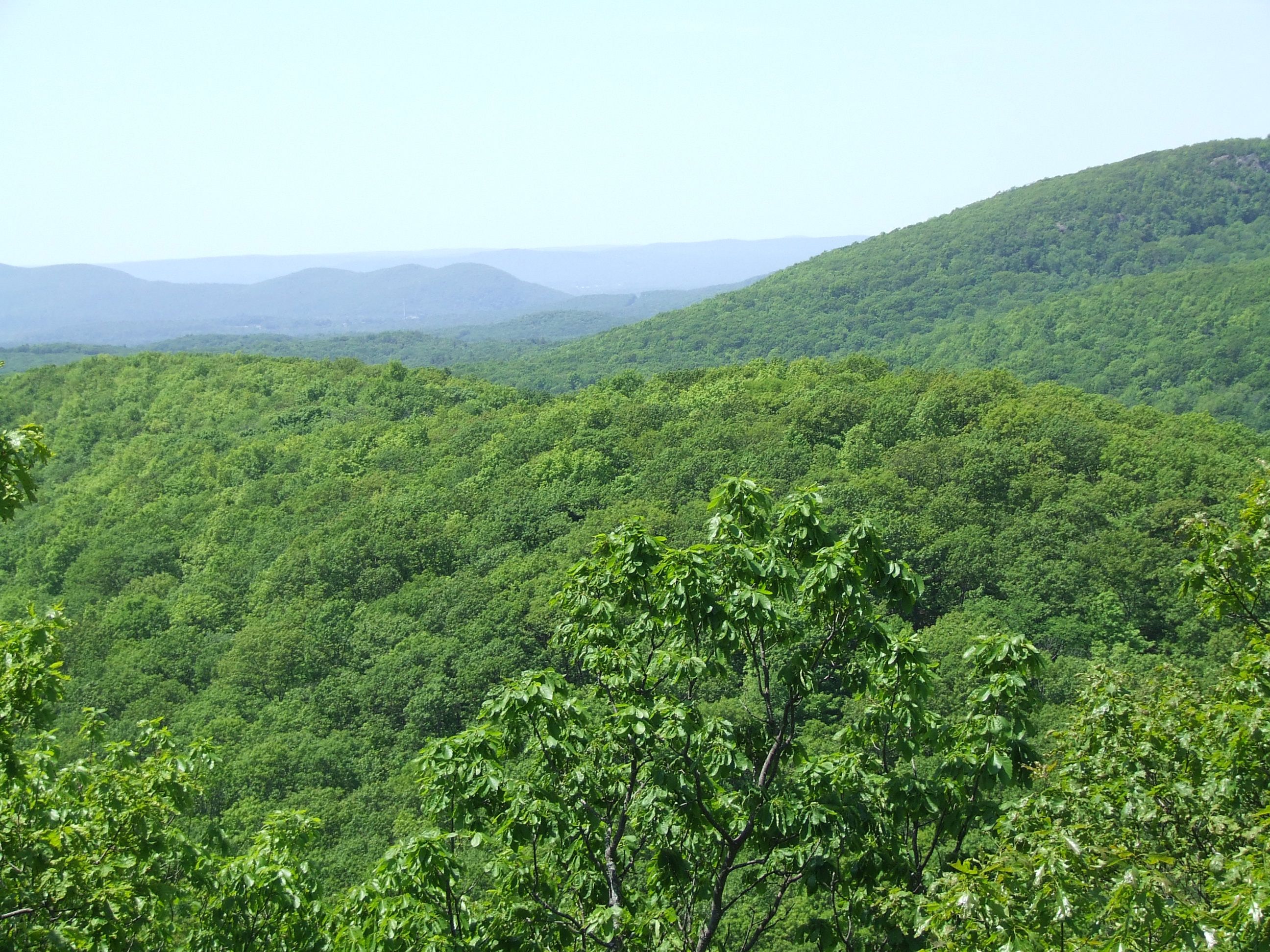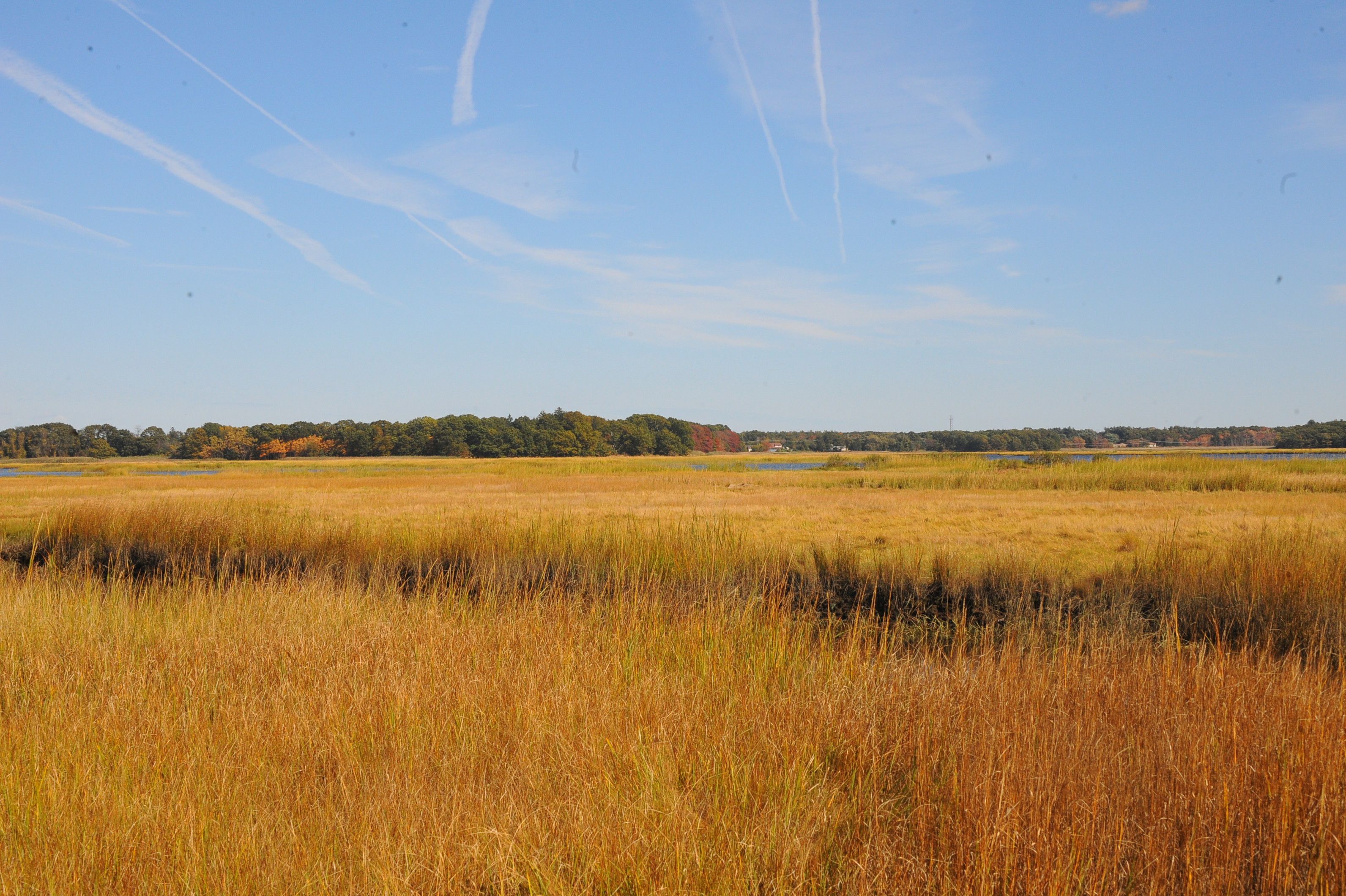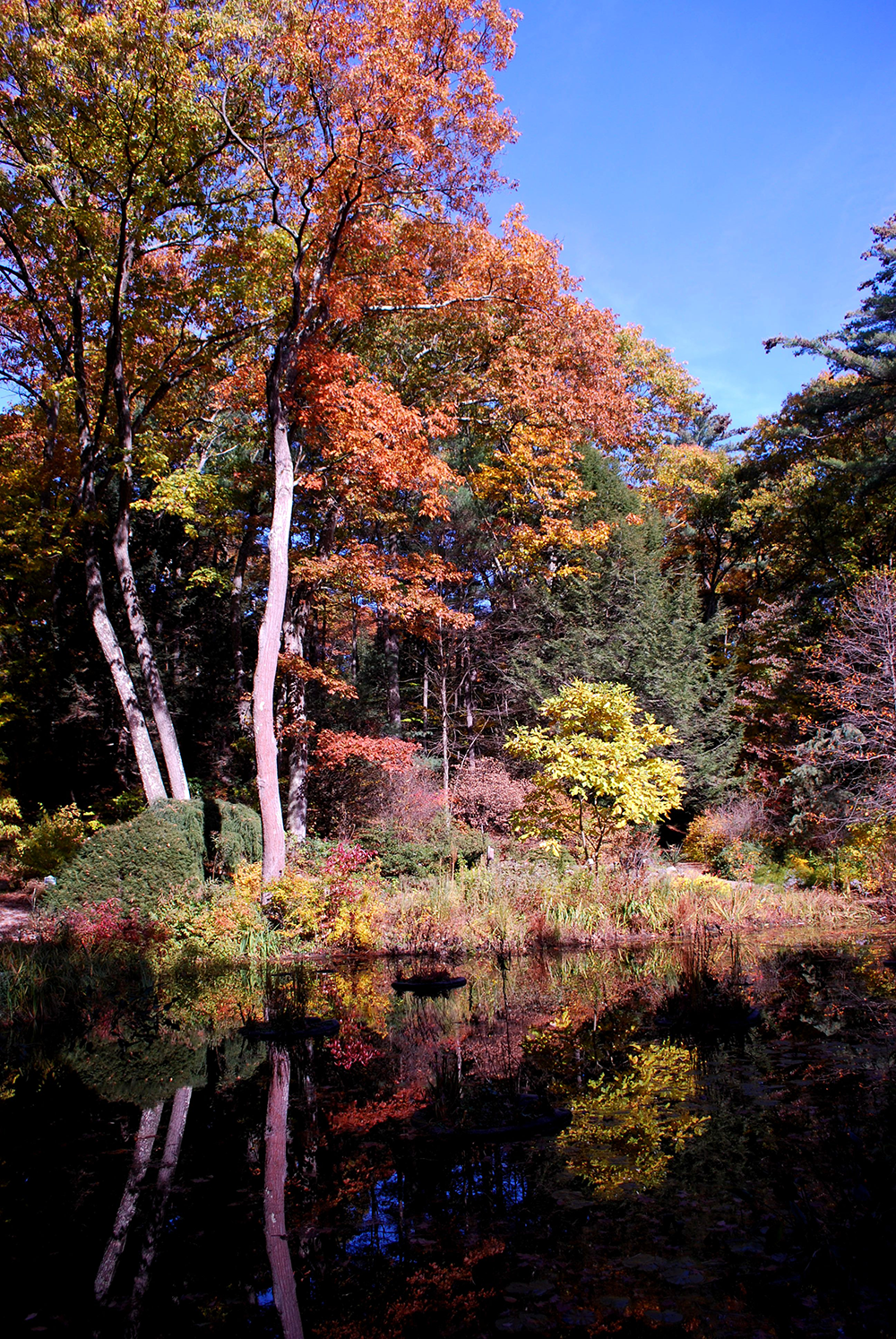Checking Up on Native Plants
Air Date: Week of May 8, 2015
NewEnglandWildFlowerSociety2015.png)
The Curtis Woodland Garden, Garden in the Woods in Framingham, Massachusetts. (Photo: Elizabeth Farnsworth, New England Wild Flower Society)
Spring is the season for the first wild flowers to appear, and despite this year’s severe winter, native wild flowers are starting to bloom at the New England Wild Flower Society’s Garden in the Woods. But climate change, aggressive invasive species and insects are stressing some iconic plants, so a group of experts produced a report on the state of New England’s plants. Host Steve Curwood a takes a walk in the woods with the Wild Flower Society’s senior research ecologist Elizabeth Farnsworth to find out what’s going on.
Transcript
CURWOOD: May 4 started National Wildflower Week in the US, devoted to celebrating the wealth and beauty that carpet woods and meadows for free. So with spring so late here in Boston, for a glimpse of some blooms we headed out to a nearby suburb for a walk in the Garden of the Woods, the showcase and laboratory for the New England Wildflower Society.
There are some 3,500 species and subspecies of native plants in the region that are used to tough winters, though they are under stress from climate change, development and invasive species. We arranged to meet Elizabeth Farnsworth, the Senior Research Ecologist for the Wild Flower Society at its 30-acre woodland garden. She’s the lead author of this year’s “State of the Plants Report”, the most comprehensive assessment of native plants and plant communities ever assembled in the region.
[WALKING OUTDOORS, BIRDS CHIRPING]
Hi there, I’m Steve Curwood. And you are Elizabeth Farnsworth?

The alpine region is one of the habitats described in the New England State of the Plants report. (Photo: Elizabeth Farnsworth, New England Wild Flower Society)
FARNSWORTH: Yes, indeed.
CURWOOD: We're here at the Garden in the Woods. So what's here?
FARNSWORTH: So what we have here is one of the most beautiful naturalistic gardens, one of the oldest in eastern North America. It has a wonderful selection of plants that, of course, you can use in your own garden, but also that broadly represents habitats of New England. So we've tried to really re-create the diversity of the different habitats, we have bogs, we have a beautiful pond here, we have a sand plain habitat that we just installed, so a whole range of different types of plantings.
CURWOOD: Now why do native plants matter here? There are wonderful plants like the daffodils and tulips that come from elsewhere that grace gardens. So why are native plants important?

The New England Wild Flower Society's Garden in the Woods in full bloom. (Photo: Elizabeth Farnsworth, New England Wild Flower Society)
FARNSWORTH: Native plants evolved here. They evolved in these climates in the peculiar habitats of New England and all of the organisms that depend on them co-evolved with these plants. And so if you look at the tulips in your garden or the daffodils in your garden, how many bees are actually visiting those, how many butterflies are coming in to actually pollinate those plants versus if you look at some native plants all around you you'll notice that diversity is really attractive to them.
CURWOOD: So you recently completed a study of the region's plant life, how well it's doing, native, non-native, invasive, all that sort of thing. In brief, how are native plants doing in this region?
FARNSWORTH: So about 22 percent of our native flora are regarded as rare, that is endangered, threatened, special concern or even historic in one or more new England state. So close to 100 species, about 96 species, are now no longer known to New England. They may exist elsewhere somewhat precariously, but they're no longer here and that's a pretty substantial number of the majority of our flora is affected, about 30 percent have been brought from elsewhere introduced purposefully or mistakenly, that's about on par with other regions of the country. But about 10 percent of that set of non-native species are regarded as invasive. So that's 111 species.
CURWOOD: Invasive means trouble?

Northern hardwoods (Photo: Elizabeth Farnsworth, New England Wild Flower Society)
FARNSWORTH: Invasive means that these are plants that can grow quite aggressively. They can overtake native plants, they can outcompete them. They can come to dominate a particular habitat, so it becomes very impoverished in terms of plant diversity and often animal diversity.
CURWOOD: So let's talk about the big ones, what about trees, how they doing in this region?
FARNSWORTH: Well, trees are facing a number stresses and it's actually a good example right here at the garden. We have had to remove a number of Hemlock trees. These Hemlock trees have been attacked by these tiny white insects, the Hemlock woolly adelgid, which is spreading across New England. It's beginning to be seen further north. We have the Ash trees, which are being affected by the Emerald ash borer, which is on our doorstep, moving into western portions of New England. We have Sugar Maples that are showing some signs of being stressed by warmer temperatures, not necessarily pests or pathogens yet, but a lot of the climate models do predict a northward sort of contraction of the range of Sugar Maples, and that's, of course, an iconic tree for New England but also very important to our economy.

A riparian zone is a wetland area, often the adjacent to rivers and streams. (Photo: Elizabeth Farnsworth, New England Wild Flower Society)
CURWOOD: As I look around, I see some big trees here. There's this big Red Oak. How are these trees doing?
FARNSWORTH: Red Oaks are holding their own so far. We're worried about Sudden Oak Death which, of course, is the scourge of oaks in California with people transporting wood and potentially transporting disease, Red Oaks, of course, and we may remember that certain caterpillars really ravaged them, particularly in the 60s, Gipsy Moth caterpillars. I can recall from my childhood just listening to the rain of Caterpillar frass and complete defoliation of these trees. But they're pretty resilient. These guys have been here for probably 150 years and some are doing OK. Many of the climate models suggest as the temperatures warm that Oaks and Hickories will become much more dominant on the landscape. Trees which now tend you know to be dominant further south are likely to be moving into our area even as some of our more northern adapted species begin to contract north.
CURWOOD: So tell me more about climate change what did you find when you did this valuation of the plants, the flora as you scientists call it, in this region? How is climate affecting things?

New England salt marsh (Photo: Elizabeth Farnsworth, New England Wild Flower Society)
FARNSWORTH: We're already seeing the effects of shorter winters and warmer springs, drier summers. Plants on average are flowering many of them two weeks earlier in the spring. So, we're already picking up the signal but certain plants are responding very strongly to climate change and, in fact, some of our invasive species are responding more strongly than some of our native species. So, there's certainly winners and losers in terms of how flexibly plants can actually adapt to climate change. So we understand that's going to contribute to shifting in our natural communities. It also, the flowering behavior, of course, is really important to pollinators and so if there is an off-site between early flowering plants and the emergence of their pollinators, both parties are going to be unhappy.
CURWOOD: What has flowered early in the Garden in the Woods that you think you might attribute to climate disruption?
FARNSWORTH: Well, we are starting to see the emergence of these beautiful plants call Bloodroot that are members of the poppy family. When those flowers pop out, there's going to be a very big and white….
CURWOOD: Are they early this year?

Sand plains cover a good deal of New England habitat, some of which is thanks to development in the region. (Photo: Elizabeth Farnsworth, New England Wild Flower Society)
FARNSWORTH: I think they're actually a bit late this year. Climate change is a long-term phenomenon with a lot of very ability between years. As we've seen, the garden is relatively recently free of snow, but if you compare this to two years ago when we had a very mild winter, many of these plants would've been fully in flower or even finished flowering or even close to in fruit by this time, so these plants are highly sensitive to the temperatures.
CURWOOD: So, let's take a look around this pond here. How are ponds, size of rivers, wet areas, doing in terms of native plants here in the region?
FARNSWORTH: Well, it kind of depends on what type of wet area you're talking about. So for example, ponds are doing moderately well, although acid rain has changed the chemistry particularly of our northern ponds so they are much more acidic. They can't really support a lot of the plants that used to live alongside the pond or even in the pond, so they are pretty species poor. Some ponds are beginning to recover which is good news. Other wet areas, one of which that we covered in a report, are riverside areas, floodplains, sandbars--those very changeable habitats that occupy river systems. And they're extremely productive, they're very, very, rich and they of course do help with flood control.
[WALKING]
NewEnglandWildFlowerSociety2015.png)
Sarracenia purpurea is a purple pitcher plant found around bogs. It's carnivorous and feeds on small insects. (Photo: Elizabeth Farnsworth, New England Wild Flower Society)
Now for something completely different this is a sand plain community. It is extremely dry habitat, think of Cape Cod, think of Martha's Vineyard, think of much of southern New England where the glaciers kind of dumped their sandy load. You'll see the plants that are growing on this landscape are kind of low and scraggly, Pitch Pine here. We have some nitrogen-fixing plants here like Bayberry so they're some of the first pioneers they can come into these really, really nutrient poor habitats, very dry habitats and survive.
CURWOOD: So in your study how are these plants doing? How is this biome doing?
FARNSWORTH: So sand plant habitats are really great for building things like cities and airports and suburbs because, of course, sandy soils perk, they tend to be nice and flat. So we've lost about 60 percent of the sand plains that were known from New England when the colonial settlers came in.
CURWOOD: So, this looks like cactus.
FARNSWORTH: Believe it or not we have a native cactus species in New England, and it is considered one of our rarest species. This is an Opuntia; it's a Prickly Pear cactus. And it grows in these tremendously dry, sand plain kinds of environments, sand dunes, other areas along the coast, and it's only known from a few populations. So one of the reasons that we feature these habitat gardens is to give people an idea of what kinds of native plants could grow in their own particular growing conditions. They'll grow up a lot better and that non-native Barberry that you're trying to get started.
NewEnglandWildFlowerSociety2015.png)
Garden in the Woods reproduced a sand plain habitat showcasing different varieties of native plants that grow in dry, sandy conditions. (Photo: Elizabeth Farnsworth, New England Wild Flower Society)
CURWOOD: Now, we're here in New England which is its own special place, but somebody listening to us in, say, New Mexico or California or Colorado...what would you suggest to them?
FARNSWORTH: I would suggest much of the same thing that we're doing here in New England and, in fact, by writing the report, we really wanted to begin a national conversation. You know, each of the different states are sort of doing their own thing, some states working harder than others to really maintain their native flora. Some states have more resources than others. Perhaps we can collaborate. California has its share of floodplain habitats that are being impacted. New Mexico has its share of sand plain habitats they're being impacted. So there are important lessons that really cross state boundaries.

Fall in Framingham, Massachusetts' Garden in the Woods. Several varieties of trees surround their lily pond. (Photo: Elizabeth Farnsworth, New England Wild Flower Society)
CURWOOD: So, what's the risk of not knowing about plants around us?
FARNSWORTH: When you don't know the plants around you, you won't know what you've lost when they're actually gone due to habitat destruction or disease or climate change, any of these threats. So it's really important that we understand that the plants are the foundation and when you start losing important species and this diversity of species then pretty soon Rachel Carson, and we get into many, many years ago, you won't hear the birds, you won't start to encounter the many animals, you won't see the butterflies, and then you make it any point of just how impoverished the natural community around you has become.
CURWOOD: What do you folks doing terms of seed saving if you're concerned about a species going away?
FARNSWORTH: So we do have a very active seed collection program. We are the largest seed bank for rare plants in the region, and we have both volunteers and staff who go out and collect seed very prudently from rare plant populations. We never collect from more than 10 percent of the plants, but we do maintain them in seed banks. They are something of a bet-hedging strategy, and we actually successfully recovered a species that was on the federally endangered species list.

Living on Earth's host Steve Curwood speaks with Elizabeth Farnsworth with producer Lauren Hinkel. (Photo: Jennifer Stevens-Curwood)
CURWOOD: And that was?
FARNSWORTH: That was Robin's cinquefoil. It's a very diminutive little member of the Rose family found only from a few populations on Mount Washington. So in the Alpine, the main population was being completely destroyed by trampling.
CURWOOD: Hikers.
FARNSWORTH: Hikers, and we actually restored many, many plants in the population and actually started a new one close by, so the plant was delisted. It's the only one in the US that's ever been taken off the endangered species list. So the report spells out all of a lot of the hazards for New England's rare plants in particular, but there's also some good news in there. Plants are really very resilient and there are actually things that we can do individually and collectively to celebrate flora and to make it resilient for the future.
CURWOOD: Elizabeth Farnsworth is a Senior Research Ecologist at the New England Wildflower Society. Thank you for taking the time with us today.
FARNSWORTH: Thank you so much. It was delightful talking with you.
Links
Living on Earth wants to hear from you!
Living on Earth
62 Calef Highway, Suite 212
Lee, NH 03861
Telephone: 617-287-4121
E-mail: comments@loe.org
Newsletter [Click here]
Donate to Living on Earth!
Living on Earth is an independent media program and relies entirely on contributions from listeners and institutions supporting public service. Please donate now to preserve an independent environmental voice.
NewsletterLiving on Earth offers a weekly delivery of the show's rundown to your mailbox. Sign up for our newsletter today!
 Sailors For The Sea: Be the change you want to sea.
Sailors For The Sea: Be the change you want to sea.
 The Grantham Foundation for the Protection of the Environment: Committed to protecting and improving the health of the global environment.
The Grantham Foundation for the Protection of the Environment: Committed to protecting and improving the health of the global environment.
 Contribute to Living on Earth and receive, as our gift to you, an archival print of one of Mark Seth Lender's extraordinary wildlife photographs. Follow the link to see Mark's current collection of photographs.
Contribute to Living on Earth and receive, as our gift to you, an archival print of one of Mark Seth Lender's extraordinary wildlife photographs. Follow the link to see Mark's current collection of photographs.
 Buy a signed copy of Mark Seth Lender's book Smeagull the Seagull & support Living on Earth
Buy a signed copy of Mark Seth Lender's book Smeagull the Seagull & support Living on Earth

